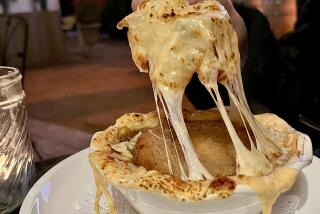Historical Scoop on Silver Spoon Inherited From Mother-in-Law
- Share via
WHAT IS IT?
This is a sterling-silver seafood or oyster spoon made in 1895 by Towle in its Old Colonial pattern, which the company still makes. The spoon is asymmetrical to allow for easy scooping.
WHAT’S ITS HISTORY?
Nineteenth-century American silverware chests were more elaborately filled than their European counterparts. Serving spoons, such as this spoon, were in abundance. Other unusual pieces included bonbon spoons, nut spoons and mustache spoons.
“American silver is less collectible than English silver, and because of this, there are many different serving pieces around, like grapefruit spoons, lettuce forks and olive spoons,” says Nina Khodorovsky, owner of Antiques 4 U in Newport Beach. “What’s unusual about this piece is the gold wash on the bowl. Usually this meant the owner went to a silversmith and had it done specially.”
WHAT’S THE LEGEND?
This spoon was bequeathed to Beverly Bush Smith of Lake Forest by her mother-in-law, Jesse Gedge Smith. “I never saw this when she was alive,” says Smith. “Her family liked to entertain, so I guess that’s why she kept it. I’ve had the spoon for about three years, and during that time it’s become a game in our family to guess what it was used for. We’ve had every guess from cantaloupe scoop to cranberry jelly spoon.”
WHY IS IT POPULAR TODAY?
Author Stephen Helliwell, in “Small Silver Tableware, The Connoisseur’s Guide” (1996, Bullfinch Press, $12.95), writes, “Collecting silver is a relatively new phenomenon, and there is now a steady market for fine tableware.”
This is because silver is a less risky investment than many other types of antiques, and people on limited budgets can afford some pieces.
WHAT’S IT WORTH TODAY?
This serving piece would sell from $79 to $89, says Khodorovsky. “This is not part of a set, but a single serving piece. Although it’s very pretty, it’s not particularly unusual.”
WHERE CAN I FIND IT?
Most antique stores carry silver flatware. Be sure to check for hallmarks designating “sterling” on the piece so that you buy true sterling and not silver-plate. Any pitting on the piece would indicate silver-plate.
WHERE CAN I LEARN MORE?
Most books on antiques have chapters on silverware. Towle maintains a Web site (https://www.towle.com) and another site, https://www.silversmithing.com, lists books on silver and links to other sites.
* To have an item considered for this column, send information, your phone number and a photograph of the item to: What’s It Worth?, Home Design, The Times Orange County, 1375 Sunflower Ave., Costa Mesa, CA 92626.
More to Read
Sign up for The Wild
We’ll help you find the best places to hike, bike and run, as well as the perfect silent spots for meditation and yoga.
You may occasionally receive promotional content from the Los Angeles Times.






